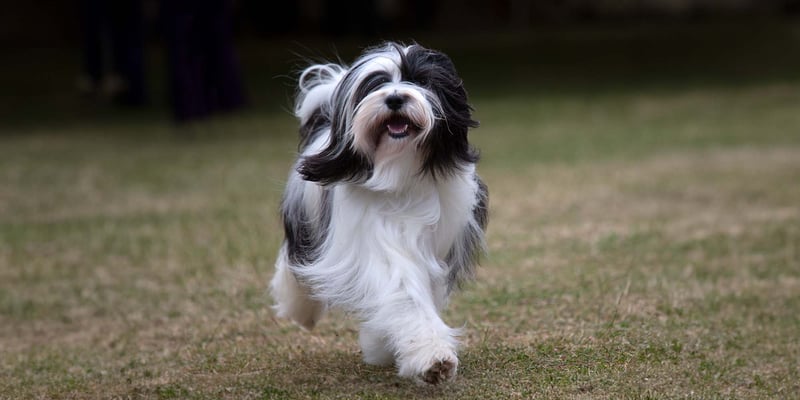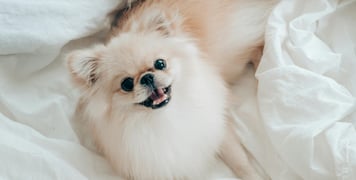Dogs That Don't Shed - Dog Breeds With Little to No Shedding
Index:



Introduction
Owning a dog is a priceless experience, but the constant shedding can become frustrating.
It seems like no matter how often you vacuum or sweep, there's always hair all over the place. And if you have dark clothes, you know that they'll be covered in pet hair within minutes.
If you're considering getting a dog but are put off by the thought of all that relentless shedding, don't worry!
It may seem unbelievable, but there are actually several breeds of dogs that don't shed much at all.
No, really, it's true!
In this article, we'll introduce you to some of the dog breeds that don't shed. These are much better hypoallergenic breeds which are also perfect for busy people who hate cleaning up vast amounts of hair.
Big dogs that don't shed
The following large breeds are dogs that don't shed or are known to be relatively low shedders:
Standard Poodle



These big, impressive dogs have a single-layered coat with no secondary under-layer of soft, downy fur.
They have a variety of colours and can have a white coat, black, silver, grey, brown, red and more.
The standard Poodles' coat is also dense, wavy, or a curly coat, which keeps any shed hair trapped within the coat rather than falling out on the floor or your clothes.
Grooming through regular brushing keeps the coat healthy and free of any loose hair.
A Poodle's coat constantly grows throughout the year, and they're not prone to sudden seasonal shedding. This is especially true around spring and autumn when most other dogs tend to blow their coats and leave you knee-deep in fluff!
Afghan Hound



These elegant dogs are another non-shedder. Afghans also have a single coat that grows consistently, just like human hair, which means it never reaches that annoying shedding phase.
They will, however, go through a brief period of shedding during the transition from pup to adult.
Afghan pups have short, fluffy fur that starts to fall out between nine to twelve months old, at which point the new coat begins to grow.
This can be a messy time, with lots of extra shedding and grooming required to deal with knots and tangles. Luckily, it's only temporary!
Once this short period is over, you'll be mostly hair-free!
Komondor



This large, sheepdog-like breed is covered in a thick mop of cords and looks suspiciously like Dougal from the Magic Roundabout.
Their coat is made up of an outer layer of long, coarse hair and an undercoat of soft, downy fur.
Komondors do shed, but their coat is so dense that it effectively traps any shed hair within the cords rather than letting it fall out.
However, this breed does require a lot of maintenance, as the cords can quickly become matted and tangled if they're not looked after regularly.
If you're up for the challenge, then a Komondor could be the low-shedding dog for you!
Medium sized dogs that don't shed
These medium-sized dogs are also relatively low shedders:
Standard Schnauzer



This breed's dense, wiry outer coat comes in black or salt and pepper and can be up to 2 inches long. They also have a secondary soft, thick undercoat that keeps them insulated from harsh cold and hot weather.
Schnauzers are not entirely "non-shedding", as some people may claim.
In fact, all dogs with hair shed to some extent, but the good news is that Schnauzers only shed a tiny amount.
Shedding may increase a little during particular seasons, such as spring, but don't panic; it's quite normal.
Your Schnauzer is just getting rid of their winter coat in preparation for summer.
It may be more noticeable than normal, but nothing like the sheer carnage a heavy shedder like a German Shepherd can wreak.
Tibetan Terrier



These hypoallergenic companions have a long shaggy coat that catches rogue hair shed from their fluffy undercoat.
Tibetan Terriers will need some serious grooming, such as regular baths and weekly brushings or keeping their coat short in a "puppy cut."
The latter option could create problems for those owners that specifically want a low-shedding dog. A puppy cut removes the topcoat that causes Tibetan Terriers to visibly shed on clothing or soft furnishings.
Puppies shed a lot of their fur at around nine months old, so it's critical to groom them frequently during this period.
Airedale Terrier



Bred initially in Yorkshire, the Airedale Terrier is a medium-sized terrier known for being confident and independent with almost unlimited energy. This means you will have to supply them with mental stimulation such as walkies and playtime.
Airedales are feisty pups that are low shedders compared to other dogs their size.
This happens because of their double coat, which consists of a dense outer layer. Their wiry coats have a soft, downy undercoat.
They shed moderately throughout the year and a little more heavily during spring and autumn shedding seasons.
A good regular brushing regimen will help remove any loose hair and keep their coat healthy and shiny and your home free of Airedale hair as will the occasional bath.
Small dogs that don't shed
Here are some of the teeniest dogs that don't shed much:
Bichon Frise



These floofy little pups look like mini clouds with legs. They are great for people with allergies because as well as being low shedding, they are also hypoallergenic.
They are mostly white in colour, but some have a touch of cream, buff, or apricot mixed in their velvety soft fur.
They are born sporting a single coat, but as they reach maturity, they develop a second dense coat, making them look so fluffy.
This devastating combination of coats makes them incredibly light shedders compared to lesser double-coated dogs.
When they do shed, it's a seasonal thing, and you'll probably only notice a few extra hairs on your clothes or furniture. This is because that fluffy top layer catches nearly all those hairs.
This breed may be a low-shedder, but they are high maintenance when it comes to grooming.
Bichon Frises need daily brushing to prevent hair from matting, and they also need to be trimmed every few months.
Don't let this put you off, however, as they are an excellent companion and will quickly become your family's centre of attention.
Yorkshire Terrier



The Yorkshire Terrier is one of the most popular breeds in the world, and it's not hard to see why.
They are small dogs with larger-than-life personalities, and while they're not barking at anything that moves (what excellent, scary little guard dogs), their friendly disposition means they love to cuddle up on any available lap for some much-needed tummy tickles followed by a nice snooze.
They have a long, silky single-layered soft coat that continually grows until it reaches its maximum length, at which point it stops.
With no second layer of fur to shed, they don't blow their coat seasonally like other dogs with dual-layered coats.
However, grooming could be a big job if you want your Yorkie to have long flowing hair that is tangle-free.
If you want to avoid the hassle of constant grooming, you could always opt for a 'puppy cut', which is a shorter version of the Yorkie cut and much easier to maintain as it requires minimal to no brushing.
But you will need to book consistent grooming appointments for a trim every few weeks.
Maltese



This is another small dog breed with a beautiful long, silky coat. Maltese are born with a single layer of fur, which is technically hair since they don't have an undercoat.
Like Yorkshire Terriers and Afghan Hounds, they are known as 'continuous shedders', meaning their hair keeps growing and doesn't fall out in clumps like dogs with double coats.
So, while they don't technically shed, you will find the odd hair on your clothes, furniture, and floors if you don't brush them regularly. But doesn't compare to the sheer volume of a shedding dog.
The Maltese need to be groomed frequently and brushed every day to prevent their hair from matting.
Matting is a serious issue for Maltese dogs as it can pull on their skin and cause discomfort and pain.
So, if you're thinking of getting a Maltese, be prepared to put in the brush time or take them for regular grooming appointments although they will certainly be your furry-friendly companion for years to come.
Non-shedding dogs are not hypoallergenic
Before we wrap up, we want to clear up one common misconception.
Just because a dog is a low shedder or doesn't shed at all doesn't mean they're hypoallergenic breeds so take note allergy sufferers.
Hypoallergenic dog breeds are those that produce less of the protein that causes allergies in people.
However, non-shedding dogs and dogs with a hypoallergenic coat are not necessarily one and the same.
For example, the standard poodle is considered a non-shedding dog, but they're not hypoallergenic.
So, if you suffer from pet allergies and you're looking for a truly hypoallergenic dog, you'll need to do some additional research.
But if shedding is your main concern, any of the dogs on our list would be a good contender as family pets.
There are also other popular dog breeds which deserve an honourable mention such as the Shih Tzu, Scottish Terrier, Cairn Terrier, Giant Schnauzer, and other terrier breeds like the Border terrier and Silky terrier.
Conclusion
While dogs give us endless amounts of love and companionship, they also come with the added bonus of shedding.
For some people, this is a deal-breaker. But it doesn't have to be!
There are plenty of dogs that don't shed or only shed minimally.
So, if you're looking for dog breeds that don't shed, like the Yorkshire terrier and Maltese, you now have some options to choose from to keep your home and clothes free from pup fluff.
Looking for more helpful information? Why not see our puppy insurance guide or our guide to the top 10 best breeds in the UK? Or maybe you need some tips on puppy toilet training or how to stop a puppy biting.
Well luckily for you, we’re always here to provide you with the most engaging and informative content to help you on your journey towards happy pet ownership.
Waggel Pet Insurance
Need more help? You're in luck if you're a Waggel Pet Insurance member. Along with our excellent coverage, we offer access to a 24/7 online vet to answer all your sticky questions, especially if you need grooming assistance.
Not a member? Why not get a quote now and cover your furry friend for a range of illnesses, all while enjoying our amazing perks and rewards.
Want more like this?
Get updates from us with helpful info, advice, answers to frequently asked questions and much more.
Index:
Related posts:
Get your quote
Along with our excellent coverage, we offer access to a 24/7 online vet to answer all your sticky questions.





